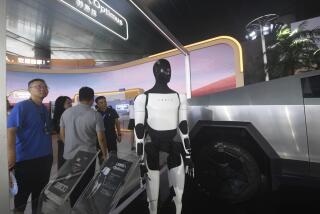The sum of their graphic parts
Though reviews have been less than kind to the human stars in Michael Bay’s mega-budgeted Hasbro toy story, “Transformers,” critics have raved over the realism and complexity of the computer graphically created Autobots and Decepticons.
“None of us like phony baloney CG fake stuff,” says Oscar-winning visual effects supervisor Scott Farrar (“Cocoon”).
For far too long, says Farrar, CG effects’ artists and audiences have been too accepting of unrealistic looking computer-rendered special effects. “I kept thinking for a long time that we are dumbing down. There is a patina that’s missing. That’s why I think this is at least a higher water mark to do everything we can to make it look real.”
One of the scenes he’s most proud of comes when the Autobots arrive one evening at the house of hero Sam Witwicky (Shia LaBeouf).
The gigantic robots, which include Optimus Prime and Bumblebee, are forced to hide themselves from Witwicky’s perplexed parents. Along the way, the robots rip up the garden, stomp on flowers and even find themselves being attacked by the family’s pet Chihuahua.
“There is acting involved” on the robots’ part, says Farrar, who has worked for George Lucas’ Industrial Light & Magic for the last 26 years. “There is a lot of humor and very dramatic nighttime lighting.”
That’s no small thing. After all, these robots don’t really exist, and the actors are playing to a screen, with the footage being layered in after the fact. The lighting must match up perfectly on both ends -- from the nighttime sky to the natural reflections off the robots’ exterior -- or else it will become painfully obvious to audiences.
“These are all shiny robots and we were lighting these guys as if they were on the set,” Farrar said of the robots.
Transforming the Hasbro toy line, which includes the villainous Megatron, into big-screen CG robots took 18 months, new computer programs and more than 300 people at ILM creating the 450 effects shots.
So to describe creating the robots for “Transformers” as complex, is something of an understatement.
“You have extremely challenging problems of manipulating thousands of parts in 3-D space inside the computer,” says Farrar. “And at the same time know it has got to look essentially like real robots and real metal.”
Farrar says that the robots look so real that audiences might find it hard to understand they were created in the computer. “There are no physical parts whatsoever made in our physical world,” says Farrar.
“But to build them is exactly the same as if you went out to the garage and did a good job of making all the pieces.”
A vintage Optimus Prime toy contains about 50 parts. But the CG version has 10,108 parts.
“It’s essentially the same configuration and the same layout as far as large shapes are concerned,” says Farrar. “But it’s many times greater in the computer graphic’s version.”
Every one of those 10,000-plus pieces has to be modeled and painted, via computer, if it going to be seen on camera.
“You can just imagine the complexity to get the layers of all the paint and textures and dirts and all those things that make a shiny surface on a body panel look like a painted metal surface, or dull aluminum bronze or brass.”
As for movement and transformations of the robots, Farrar and his staff attempted to follow the rules of real physics. But if the end result didn’t look cool for the camera, changed were made.
“So admittedly, all shapes don’t absolutely move the way they really should as if it’s a physically real thing, but the overall actions is correct.”
All the designs for the robots were approved by Hasbro, says Farrar. Still, the Autobots and Decepticons in the movie have more complex designs than the actual toys.
“Michael Bay had some artists developing things,” says Farrar. “He went to a more complex number of pieces in his designs.”
Every day, Farrar and his animation supervisor Scott Benza would have a live feed videoconference from their ILM offices in San Francisco with Bay in L.A.
“We would show him the shots,” he says. “He’s directing the shots, but he would always welcome proposals on our part. Michael had never done a film like this, so he had a bit of a learning curve, but he really caught on to what we were doing,” especially when it came time to direct the performances of the Transformers. “Michael is really sharp about poses and when to look at the camera after working with actors,” says Farrar. “I have that background in cinematography, so it was really a good complement.”
More to Read
The biggest entertainment stories
Get our big stories about Hollywood, film, television, music, arts, culture and more right in your inbox as soon as they publish.
You may occasionally receive promotional content from the Los Angeles Times.











